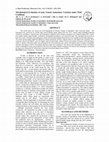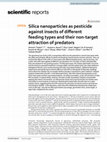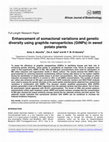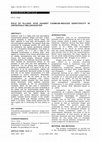محاضرات اساسيات وراثة الفرقة الاولي by Ola A . Galal
Professor of molecular genetics and cytogenetics http:/kfs.academia.edu/olagalal الوراثة اساسي... more Professor of molecular genetics and cytogenetics http:/kfs.academia.edu/olagalal الوراثة اساسيات مقرر ( 11201 ) المستوى األول -خريفي فصل الشيخ مفز جاهعت الزراعت مليت الوراثت قسن ا لترجمة Translation
Teaching Documents by Ola A . Galal
Papers by Ola A . Galal
Journal of the Faculty of Agriculture, Kyushu University
Preparation of plant samples Vicia faba seeds were grown following Thabet et al. (2019). Briefly,... more Preparation of plant samples Vicia faba seeds were grown following Thabet et al. (2019). Briefly, seeds were surface sterilized with 2.5% sodium hypochlorite (NaOCl), then washed by distilled water three to four times followed by immersing in distilled water for 6 h. The seeds were then soaked for 24 h in n-SiO 2 and n-TiO 2 , at three concentrations (25, 50 and 75 mg/L) each as well as in distilled water as a control (0 mg/L). After the treatment, the seeds were thor-RAPD Analysis of Genotoxic Effects of Nano-Scale SiO 2 and TiO 2 on Broad Bean (Vicia Faba L.

Journal of Plant Production, 2018
The Experiment was carried out at a private farm, Kafr El-Sheikh, Egypt, during 2010 and 2015 sea... more The Experiment was carried out at a private farm, Kafr El-Sheikh, Egypt, during 2010 and 2015 seasons which including producing somaclones, greenhouse evaluation and field experiment evaluation. Field evaluation experiment was conducted during 2015 season. Four tomato varieties, Super StrainB , Castle Rock, AdvantageII, and Edkawy were used in this study. Ten somaclones has been driven from each variety. Yield and yield components, quality and some physiological characteristics were evaluated for all tomato genotypes. The results showed highly significant differences among somaclones and their original cultivar in all studied traits. Generally, SE10 somaclone driven from Edkawy gave the highest values of plant height, number of leaves and number of clusters, while the highest values of number of branches /plant were produced by SE1 driven from the same variety. The highest values of number of fruit/plant and total yield /plant as well as fruit firmness and fruit weight were recorded by SA6 driven from Advantage II variety. The highest values of chlorophyll content was produced by SS5 driven from Super StrainB. Somaclone SA2 driven from Advantage II variety had the largest size. Somaclone SC7 driven from Castle Rock showed the highest mean of TSS%.
Journal of the Faculty of Agriculture, Kyushu University, 2020
The target of this research is to study the toxic effect of silver nanoparticles (AgNPs) on seed ... more The target of this research is to study the toxic effect of silver nanoparticles (AgNPs) on seed germination and seedling growth of faba bean (Vicia faba L.). Seeds of V. faba were soaked in 50, 100, 200 and 400 mg/L of chemically synthesized AgNPs for 24 h. The shoot length was significantly reduced upon exposure to 200 mg/L of AgNPs compared to the control. There was no significant difference in root elongation, although the number of lateral roots decreased significantly at 200 and 400 mg/L compared to the control. Seedling vigor index decreased only at 200 mg/L. Conclusively, AgNPs were toxic to seedling development of V. faba at high concentrations. This study also showed that the number of lateral roots is a useful index to evaluate the effect of nanomaterials on early seedling growth.

The agricultural use of silica (SiO 2) nanoparticles (NPs) has the potential to control insect pe... more The agricultural use of silica (SiO 2) nanoparticles (NPs) has the potential to control insect pests while the safety and tritrophic effects on plants and beneficial natural enemies remains unknown. Here, we evaluate the effects of silica NPs on insect pests with different feeding niches, natural enemies, and a plant. Silica NPs were applied at different concentrations (75-425 mg/L) on field-cultivated faba bean and soybean for two growing seasons. The faba bean pests, the cowpea aphid Aphis craccivora and the American serpentine leafminer Liriomyza trifolii, and the soybean pest, the cotton leafworm Spodoptera littoralis, were monitored along with their associated predators. Additional laboratory experiments were performed to test the effects of silica NPs on the growth of faba bean seedlings and to determine whether the rove beetle Paederus fuscipes is attracted to cotton leafworm-infested soybean treated with silica NPs. In the field experiments, silica NPs reduced the populations of all three insect pests and their associated predators, including rove beetles, as the concentration of silica NPs increased. In soybean fields, however, the total number of predators initially increased after applying the lowest concentration. An olfactometer-based choice test found that rove beetles were more likely to move towards an herbivore-infested plant treated with silica NPs than to a watertreated control, suggesting that silica NPs enhance the attraction of natural enemies via herbivoreinduced plant volatiles. In the laboratory, while silica NPs inhibited the development of faba bean roots at 400 mg/L, they did not affect germination percentage, germination time, shoot length, or vigor index compared to the control.

Insects quickly develop their resistance to conventional synthetic chemical insecticides. Silica ... more Insects quickly develop their resistance to conventional synthetic chemical insecticides. Silica nanoparticles (SiO2NPs) is a new promising approach not only in decreasing insect pest numbers but also for its safety regarding agricultural organisms such as plants and beneficial natural enemies. Here, we investigate the safety of SiO2NPs on the faba bean Vicia faba (Fabaceae) as a model plant for toxicity studies and its control efficiency against the American serpentine leafminer Liriomyza trifolii (Diptera: Agromyzidae) as a major devastating insect pest against a wide range of crops. The concentrations of 50, 100, 200 and 400 mg/L of SiO2NPs (spherical shape, 15.3 nm) as well as distilled water as the control were used to investigate the effect of the nanoparticles. Early stages of development of V. faba were evaluated. The same concentrations of SiO2NPs were applied by spraying on two weeks old bean seedlings to evaluate their toxic effect on the feeding, survival and body mass o...

African Journal of Biotechnology, 2018
To assay the efficiency of graphite nanoparticles (GtNPs) in sterilizing tissues and their role i... more To assay the efficiency of graphite nanoparticles (GtNPs) in sterilizing tissues and their role in enhancing genetic diversity, sweet potato is considered an important crop; hence its explants were used. In this experiment, GtNPs of 200, 400 and 800 ppm concentrations were used for sterilization of MS callus induction and regeneration media in Abees cultivar. The results showed that GtNPs had a good potential for removing bacterial contaminants without having side effects on the explant viability during the sterilization of sweet potato tissue in all their concentrations. Also, the percentage of callus induction increased from 98.67% in control to 100% in all GtNPs concentrations. The number of shoots per callus was enhanced at 400 ppm concentration. RAPD molecular markers and SDS-PAGE analysis were used to assess the genetic diversity of the sweet potato selected plants obtained from somaclonal variations in combination with GtNPs. Five decamer random amplified polymorphic DNA (RAPD) primers generated a total of 96 DNA fragments from the selected variants and their parent. Out of them, 82 polymorphic bands appeared with 85.42% polymorphism. The levels of DNA and protein patterns polymorphism within each treatment varied. RAPD and protein markers revealed that the concentration of 800 ppm showed the lowest similarity average among the ten selected variants and their parent. The obtained results indicated that somaclonal variation with GtNPs can be combined to increase the induced mutations frequency.

Egyptian Journal of Genetics and Cytology, 2020
Cytogenetic behavior of five wheat genotypes of Triticum aestivum (Shandweel 1, Misr 2 and Gemmiz... more Cytogenetic behavior of five wheat genotypes of Triticum aestivum (Shandweel 1, Misr 2 and Gemmiza 11) and T. durum (Benisouef 5 and Benisouef 6) in addition to their interspecific hybrids was studied. All five parental genotypes showed normal behavior in meiosis. Also, the interspecific hexaploid × hexaploid showed normal diploid pairing at diakinesis and metaphase I with average number ranged from 18.16 (C2) to 20.49 (RC2) and from 16.77 (C2) to 20.22 (C1) bivalents, respectively. And tetraploid × tetraploid showed normal diploid pairing at diakinesis and the average of bivalents were 13.95 and 13.98 for C10 and RC10 hybrids at metaphase I, respectively. So the normal decrease of laggards and micronuclei averages was recorded. Higher incidences of aberrant chromosomal structure such as the formation of univalent, laggards and micronuclei were observed in all the six interspecific pentaploid (hexaploid × tetraploid) which could be described as an abnormal compared to the six recipr...

Egyptian Journal of Genetics and Cytology, 2019
Nine Egyptian rice ( Oryza sativa L.) genotypes were assessed for DNA polymorphism using three d... more Nine Egyptian rice ( Oryza sativa L.) genotypes were assessed for DNA polymorphism using three different types of molecular markers (RAPD, SCoT and SSR). RAPD primers produced 68.70% of polymorphism and an average PIC value of 0.24. SCoT primers generated 86.54% of polymorphism and 0.28 average value of PIC. All tested SSR markers yielded amplified products and generated 104 alleles (average 6.5 alleles/marker) with PIC values ranged from 0.20 to 0.49 per marker. RM301 SSR marker produced specific alleles only in the four drought sensitive rice varieties that could readily distinguished the sensitive genotypes from the others. While, RM20A and RM302 SSR markers produced one positive unique marker in the moderate (Sakha 102) and drought tolerant (Giza 178) varieties, respectively. These markers may be usefully exploited for molecular breeding of rice for drought tolerance. On the other hand, clustering analysis using UPGMA method classified the nine rice genotypes into three gr...

Egyptian Journal of Genetics and Cytology, 2019
In an attempt to assess the genetic diversity among 18 maize inbred lines used in breeding progra... more In an attempt to assess the genetic diversity among 18 maize inbred lines used in breeding programs and to identify specific genetic markers for late wilt disease resistance, esterase, peroxidase and RAPD markers were used. Fifteen RAPD primers were successful for evaluation of 18 inbred lines of maize. These biochemical and molecular techniques were efficient in detecting genetic polymorphism with an average of 100, 100 and 83.21% for esterase, peroxidase and RAPD, respectively. For cluster analysis, the 18 inbred lines were divided into four groups based on esterase and peroxidase isozyme and three groups based on RAPD analysis. Also, the principal coordinate analysis separated the 18 inbred lines for three groups (esterase and peroxidase analyses) and two groups (RAPD analysis) and the separation was according to the imported location more than the late wilt disease resistance. On the other hand, 45 out of 2191 amplified bands were found to be useful as unique markers. All primer...

THE EGYPTIAN JOURNAL OF EXPERIMENTAL BIOLOGY, 2011
Cadmium (Cd) is a highly toxic and carcinogenic environmental pollutant. Ellagic acid (EA), a pla... more Cadmium (Cd) is a highly toxic and carcinogenic environmental pollutant. Ellagic acid (EA), a plant phenol presents in various human foods, has been reported to have both anti-mutagenic and anti-carcinogenic potential. The present study was conducted to investigate whether EA could play any protective role against genotoxicity induced by Cd in Drosophila melanogaster. Five doses of Cd: 0 (control), 1/2, 1, 2 and 4 folds of the allowable concentration in drinking water, were applied to measure some fitness parameters such as viability, developmental time and body size (thorax and wing lengths). Moreover, protein banding patterns and esterase isozymes activities were studied as biochemical effects of Cd pollutant at first, third and sixth generations of treatments. The Cd effects were studied either alone or combined with 0.07 mg/ml of EA for all Cd doses. At all Cd concentrations, viability and body size significantly decreased except for body size only at the lowest concentration (1...









Uploads
محاضرات اساسيات وراثة الفرقة الاولي by Ola A . Galal
Teaching Documents by Ola A . Galal
Papers by Ola A . Galal